A unique hybrid with delicious fruits, just like in the picture - the “Gift for a Woman” tomato and the nuances of its cultivation
A tomato with the soulful name Gift for a woman is worthy of the attention of every gardener. Its amazing pink large fruits will not leave anyone indifferent. Ripe vegetables surprise not only with their ideal appearance, but also with their excellent taste characteristics. That is why it received such a name.
The hybrid will truly be a gift for all tomato lovers. Everyone who has grown it on their plot leaves delightful reviews about the culture.
Characteristics and description
The F1 hybrid is the development of Russian breeders. The culture is perfectly adapted to any climatic conditions and takes root equally well both in open beds and in protected structures.
Distinctive features
Determinate bush with a strong stem and moderate foliage, up to 70 cm high. The leaves are medium sized, dark green. Each cluster bears 4–5 fruits. Ovaries are formed in any weather conditions. The tomato tolerates hot and dry weather well. The ripening period is mid-early, the first fruits are harvested 105-110 days after emergence.
Productivity and disease resistance are high. 5–7 kg of fruits are collected from one seedling. With proper care and timely prevention, the crop is not afraid of either viral or fungal diseases, since the creators have built strong immunity into the genes of the hybrid.
The plants do not need pinching, but they cannot do without a garter. Fruitful branches strewn with ripe fruits will not withstand their weight without additional support.
Fruit characteristics
The photo shows tomatoes Gift for a woman.
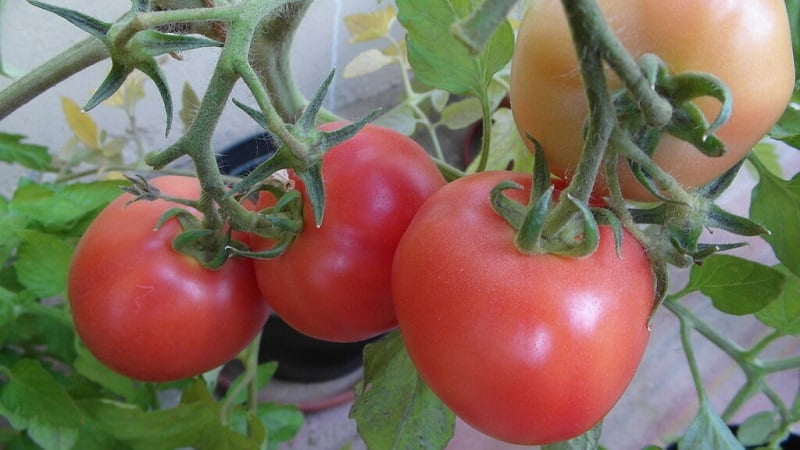 The shape of ripe vegetables is round, weight 230–250 g, color deep pink. The taste is excellent, the pulp is juicy with a small amount of seeds. The peel is dense and durable to withstand long-term transportation. Ripe tomatoes retain their presentation for 1.5 months.
The shape of ripe vegetables is round, weight 230–250 g, color deep pink. The taste is excellent, the pulp is juicy with a small amount of seeds. The peel is dense and durable to withstand long-term transportation. Ripe tomatoes retain their presentation for 1.5 months.
The purpose in cooking is universal. Ripe vegetables are great for fresh consumption and for winter preparations. But it won’t be possible to preserve the whole thing due to its large size.
Tomatoes are used for baby food and processed into tomato products.
How to grow seedlings
Seeds are sown 2 months before planting in the ground. The level of germination depends on proper preparation of seed material.
Seed preparation
Since this is not a variety, but a hybrid, you won’t be able to collect the seeds yourself—you’ll have to buy them. Viable specimens are checked by immersion in saline solution for 10 minutes. Those grains that float to the surface are empty inside, which means they are not suitable for planting. The remaining grains are disinfected in a weak solution of potassium permanganate for 20–25 minutes.
Disinfection of seed material is necessary for healthy seedling growth, but many seed producers carry out this procedure in advance. After disinfection, the seeds are washed with running water and dried.
Container and soil
For planting, a common wooden box or individual containers, for example, plastic and peat cups, are suitable. Planting containers are treated with a dark solution of potassium permanganate. Drainage holes at the bottom of each container serve to drain excess moisture.The accumulation of excess moisture can provoke rotting of young roots and the development of fungal diseases.
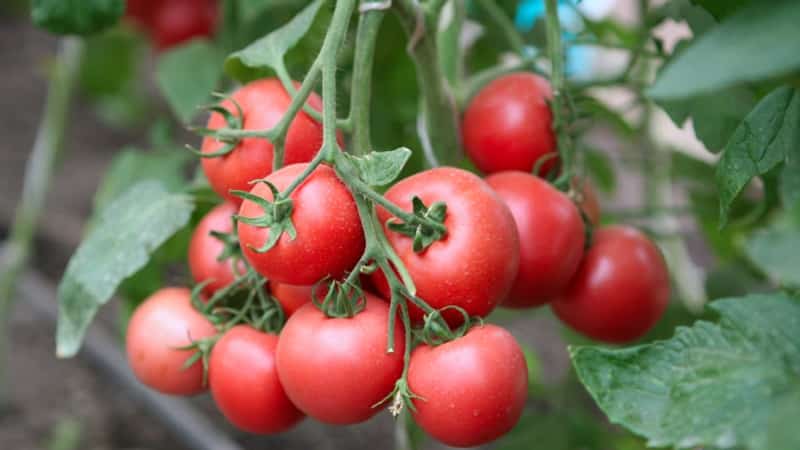
The soil is prepared from a mixture of garden soil and humus. To make the soil lighter, washed river sand is added. The resulting mixture is steamed in the oven at a temperature of 60°C for 10 minutes or poured with a hot solution of manganese. After wintering, many pathogenic microorganisms remain in the soil that can cause serious damage to plantings. To destroy them, the soil is disinfected.
Sowing
Seeds sowed in the first ten days of March. They are buried 1.5 cm, sprinkled with soil on top, watered with slightly warm, settled water using a spray bottle and covered with film. The film is needed to create a greenhouse effect; with this technique, seedlings appear earlier. The seeded containers are left in a dark and warm room at a temperature of 25°C.
Reference! When buried shallowly, the sprouts germinate along with the seed coat, which slows down their further growth.
Seedling care
As soon as the shoots appear, the film is removed and the containers are moved to the windowsill. During this period, seedlings need 14 hours of daylight. If there is a lack of natural light, care should be taken to install fluorescent lamps.
Reference! With a lack of light, the seedlings will begin to stretch and weaken.
Watering carry out only with warm, settled water in small quantities. Water as the top soil layer dries out using a shallow watering can. After watering, the soil is loosened for better access of oxygen to the young roots.
Picking is carried out when 2 true leaves appear. Seedlings Placed in separate containers with a diameter of at least 15 cm. If the seedlings are left in a common container, then the distance between them is increased to 15 cm. The picking procedure involves removing the main root by one third. After this, the lateral roots begin to grow intensively.
Reference! When growing seedlings in peat cups, picking is not required.
After picking, the seedlings are fed with complex fertilizer. This first feeding is very important for the full development of young plants.
Hardening is carried out 2 weeks before transplantation. To do this, the seedlings are taken outside in the daytime for 1 hour. Gradually, the time spent outdoors is increased to 10 hours. The daytime temperature during hardening should not be less than 16°C.
How to grow tomatoes
The soil for the beds is prepared in advance, 2 weeks in advance. The soil is dug up and wood ash is added. The holes are made no deeper than 20 cm and filled with warm water.
Landing
Planting pattern: 50 cm - distance between seedlings, 55 cm - row spacing. Transplant into prepared holes in the evening or on a cloudy day when the sun does not shine at full strength. The seedlings are installed vertically and buried down to the first leaves. After transplantation, the holes are compacted and watered with warm water.
Further care of the tomato Gift for a woman
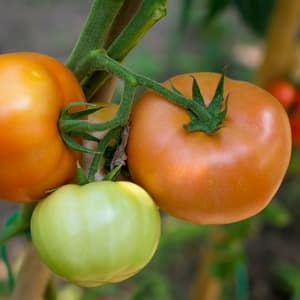 Proper care of a tomato consists of moderate watering and timely application of fertilizing.
Proper care of a tomato consists of moderate watering and timely application of fertilizing.
Regular watering is established as the seedlings get used to the new conditions. Water 2 times a week in normal weather. On dry or rainy days, watering is carried out as needed. Water only with settled water, at the roots of the plants.
After watering, the soil is loosened and weeds are removed. Weeds not only take nutrients from the soil that are necessary for the full growth of seedlings, but also serve as a good shelter for many pests. Therefore, the proximity of tomatoes to them is undesirable.
To prevent the beds from drying out and remaining moist longer, they are mulched with peat or straw. In addition, mulching protects the beds from ground pests.
Feed the tomato crop at least 3 times during the entire growing season: during flowering, during the formation of ovaries and at the time of fruiting. Feeding is a full complex of minerals or organic matter.
During the flowering period, they are fed mainly with phosphorus substances with the addition of boric acid. And at the time of fruiting, potassium substances are added for faster fruit filling. From organic matter, use mullein infusion or chicken manure in a ratio of 1:10.
Features of care and possible difficulties
Hybrid does not require stepsons, which makes it much easier to care for. There are few lateral shoots; they not only do not take away nutrients from the plant, but also do not interfere with receiving the required amount of light. But it is advisable to remove the lower leaves before the first fruitful branch, since with constant contact with wet beds they can rot and provoke an outbreak of fungal infections.
Despite their small growth, the bushes are tied to a reliable support, otherwise the stem will not withstand the weight of the fruit-bearing branches. When transplanting, a wooden or metal support is installed next to each seedling. The stem is fixed immediately after planting in the ground, and the fruiting branches tie up as they develop.
Diseases and pests
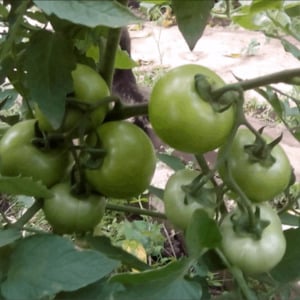 The hybrid genes contain high resistance to diseases such as: late blight, tobacco mosaic and blossom end rot. But for prevention, experienced gardeners treat seedlings after planting in the ground with fungicidal agents. This is quite enough to protect the bushes from infections throughout the season.
The hybrid genes contain high resistance to diseases such as: late blight, tobacco mosaic and blossom end rot. But for prevention, experienced gardeners treat seedlings after planting in the ground with fungicidal agents. This is quite enough to protect the bushes from infections throughout the season.
To prevent pests from entering tomato beds, strongly smelling herbs are planted or the plants are sprayed with nettle infusions.
Treating the stem with a soap solution will protect against aphids, and installing pheromone traps next to the tomatoes will protect against flying whiteflies.
A thorough inspection of each seedling will help to prevent the occurrence of disease and pest invasion in time.
This is an integral preventive measure that no gardener should forget about.
Nuances for open ground and greenhouse conditions
When planting a hybrid in a greenhouse, do not forget about constant monitoring of temperature and humidity levels. As a rule, in greenhouse conditions these two indicators exceed the norm. At elevated temperatures and humidity, favorable conditions are created for the development of pathogenic spores. To avoid this, the greenhouse is ventilated daily. In addition, a constant flow of fresh air has a beneficial effect on the growth and development of plants.
Despite its resistance to drought, it is recommended to water the hybrid regularly. A long absence of moisture negatively affects the yield, reducing it.
The annual change of the top soil layer in the greenhouse prevents the spread of fungal infections and many pests. Pathogenic microorganisms successfully overwinter on the surface, developing in the spring and causing harm to planted crops. The new land is spilled with manganese and treated with copper sulfate.
The variety is unusual in that it can be grown at earlier stages. To do this, you will need a well-heated greenhouse. Under this condition, the seeds are sown for seedlings already in February.
Harvesting and application
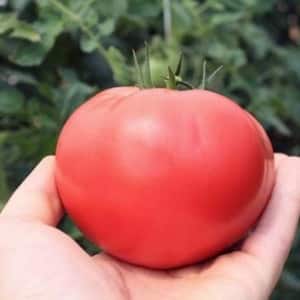 Harvesting is the most awaited stage in growing any crop. The ripe fruits of the hybrid amaze with their beauty. In the sun, the color of vegetables is especially deep and warm. The fruits are not allowed to overripe; they are removed promptly in whole clusters.
Harvesting is the most awaited stage in growing any crop. The ripe fruits of the hybrid amaze with their beauty. In the sun, the color of vegetables is especially deep and warm. The fruits are not allowed to overripe; they are removed promptly in whole clusters.
Ripe tomatoes withstand any transportation well, without cracking and maintaining their presentation for a long time. The main condition is that the vegetables should not be overripe.
Tomatoes are used universally in cooking. They are ideal for preparing summer salads, slices, and various snacks. They are used to make hot and vegetable dishes.
Twisted vegetables look great combined with red and yellow varieties. The presence of such jars on the winter table looks especially festive.
When processed, delicious juices, ketchups, adjika and lecho are obtained.
Advantages and disadvantages of a hybrid
Reviews and photos indicate the numerous advantages of culture:
- possibility of landing in all regions;
- early ripening appearance;
- drought resistance;
- unpretentious care;
- strong immunity;
- high fruiting rate;
- small height;
- does not require pinching;
- excellent taste and color of fruits;
- universal purpose;
- long storage;
- long transportations.
Conditional disadvantages include the mandatory staking of plants and the impossibility of whole-fruit canning.
Farmer reviews
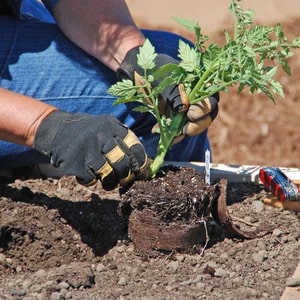 Many male gardeners, growing a hybrid on their plots, call the tomato nothing more than a Gift to my Wife. The culture not only fascinates with the beauty of ripe vegetables, but also pleases with its excellent taste.
Many male gardeners, growing a hybrid on their plots, call the tomato nothing more than a Gift to my Wife. The culture not only fascinates with the beauty of ripe vegetables, but also pleases with its excellent taste.
Sergey, Dnepropetrovsk: “I am a summer resident with extensive experience. I have tried more than 40 varieties, and now I have been planting the hybrid Gift for a Woman for three years in a row. From each bush I remove 6-7 kg of tomatoes, large fruits with excellent taste. I feed the crop with chicken manure 2 times a season. I transport to the city by car, transportation is without problems, all vegetables are kept safe and sound.”
Maria, Volgograd: “Already in August I pick large pink tomatoes of my favorite hybrid. This is a great option for preparing juice or puree for my baby. It also tastes great in salads. But it is necessary to tie it up, otherwise the branches will break off, the fruits are too heavy. I almost always grow it in open ground.”
Conclusion
Tomato Gift for a Woman f1 fully lives up to its name - it is a worthy gift for every gardener. Often, for some reason, gardeners cannot devote much time to their summer cottages.
The pink hybrid does not require much attention, is disease-resistant, high-yielding and well adapted to weather conditions. Anyone who wants to give a gift not only to themselves, but also to their loved ones should definitely plant a unique tomato in their beds.